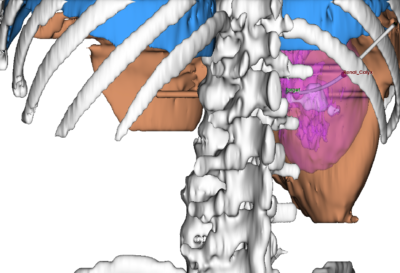We have developed an active catheter instrumented with SMA actuators. Three SMA actuators, spaced around the catheter at 1200, have been used to obtain the bending of the active catheter in all directions. The catheter is also instrumented with a 5-DOF electromagnetic (EM) sensor to provide feedback on the position/orientation of the catheter and miniature strain gauges to provide force feedback. We have developed a novel model for SMAs and a Hinfinity loop-shaping controller has been implemented to guarantee robust performance of the active catheter. A closed-loop control algorithm has been implemented to precisely orient the catheter in space based on feedback from a 5-DOF magnetic sensor. The active catheter tracks a reference trajectory generated either by a haptic device under the control of a user or from an image processing algorithm that determines the angle of a branch in the vasculature.
We have also investigated autonomous robot-assisted insertion of an active catheter instrumented with shape memory alloy (SMA) actuators using image guidance. The tip of the active catheter is tracked in real-time to provide information on the location of the catheter that determines the optimal stroke length of insertion for the robot and the necessary bending angle for the active catheter. The catheter is autonomously guided from the point of entry to the site of plaque buildup, thereby shielding the clinician from harmful radiation due to the X-rays used for imaging and providing a more ergonomic approach for catheter insertion.
The 10 mm incisions used in minimally invasive cancer surgery prevent direct manual palpation of internal organs, making intraoperative tumor localization difficult. A tactile sensing instrument (TSI), that uses a commercially available sensor to measure distributed pressure profiles along the contacting surface, has been developed to facilitate remote tissue palpation. Further, an Augmented Hybrid Impedance Control scheme was implemented on a Mitsubishi PA10-7C robot to perform force/position control during the palpation. The results showed that using the TSI under robotic control realized an average 35% decrease in the maximum forces applied, and more than a 50% increase in tumor detection accuracy when compared to manual manipulation of the same instrument. This demonstrates that tumor detection using tactile sensing is highly dependent on the consistent application of forces on the tactile sensing area and that robotic assistance can be of great benefit when trying to localize tumors during minimally invasive surgery.
Percutaneous nephrolithotomy (PCNL) is considered a first choice minimally invasive procedure for treating kidney stones larger than 2 cm. It yields higher stone-free rates than other minimally invasive techniques and is employed when extracorporeal shock wave lithotripsy or uteroscopy are, for instance, infeasible. Using this technique, surgeons create a tract through which a scope is inserted for gaining access to the stones. Traditional PCNL tools, however, present limited maneuverability, may require multiple punctures and often lead to excessive torquing of the instruments which can damage the kidney parenchyma and thus increase the risk of hemorrhage. We approach this problem by proposing a nested optimization-driven scheme for determining a single tract surgical plan along which a patient-specific concentric-tube robot (CTR) is deployed so as to enhance manipulability along the most dominant directions of the stone presentations.

Nearly two million patients in the United States are diagnosed with atrial fibrillation (AF) each year. Cardiac ablation using radiofrequency energy is becoming the preferred treatment option for AF. It involves navigating an ablation catheter in the atrium under real-time X-ray fluoroscopy imaging and an electro-anatomical map, and ablating the myocardium around the pulmonary vein, often termed PV isolation. Although the procedure has a wide adoption rate, it also has a high recurrence of arrhythmia primarily due to the creation of suboptimal lesions. The procedure is also associated with complications including cardiac perforation, tamponade, atrio-esophageal fistulas and thrombus. Repeated and prolonged X-ray exposure for the clinician can also lead to enhanced risk of cancer. A fluoroless approach using intracardiac echocardiography (ICE) is becoming a more widely adopted imaging option due to the absence of ionizing radiation and the possibility of real-time monitoring of the created lesions. However, the ICE-guided approach suffers from significant shortcomings, which include poor dexterity of the ICE catheter, difficulty in simultaneously manipulating the ICE and ablation catheters, unintuitive image orientation and noisy image quality. There is therefore an unmet need to overcome these shortcomings of the ICE-guided approach to enable better lesion creation and reduced complications associated with the cardiac ablation procedure. In this work, we develop a robotic manipulator to manipulate the ICE catheter to image the ablation catheter and the lesions created.
